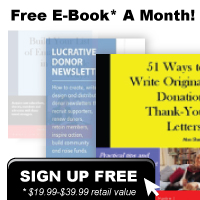 By Billy Sharma
By Billy Sharma
The art lies in building and fostering a strong bond with your supporters. This is best achieved through compelling communications and quick responses to their generosity.
- Your appeal must give a persuasive reason for giving and should identify the financial goals essential to your charity
- Work to understand your donors and offer them an appropriate plan of action
- When a gift comes in, send a thank you promptly
The science is how you use the data, research and testing methods available to you.
- Segment your donor files. Remember the RFM (Recency, Frequency and Monetary Value) rules of direct marketing
- Spend more time, effort and money on people who have given more recently, more frequently and more generously. They are the most likely to give again and could very well keep increasing their donation amounts. They are also the ones who need to be constantly reminded about your organization and should receive more communication pieces annually
- Research and test what works best for which group of donors
- Use data mining to determine affinity for giving. Some donors have a higher propensity to give than others. You could determine this by researching their lifestyle behavior and or just by noting their postal or area codes
- Track your donors’ giving history in terms of size and frequency of giving
Know your Donors
New Donors are first time givers.
Transition Donors are those who give sporadically. They have a history of giving once in a while in a 16-24 month period.
Core Donors are those who have given a gift to the charity regularly either each year or within sixteen months.
High Value Donors are those who give big gifts.
Lapsed Donors are those who have stopped giving. They fall into two categories:
- Recently Lapsed donors who have not given in the last 13-24 months;
- Deeply Lapsed donors who have not given in the past 25 months.
———————————————————————
Excerpted from The Handbook of Direct Marketing for Non-Profit Organizations, by Billy Sharma. Available in paperback from www.expertfundraiser.org




Reblogged this on Butler's Blog.
This is best achieved through compelling communications and quick responses to their generosity. They are the most likely to give again and could very well keep increasing their donation amounts. Some donors have a higher propensity to give than others. Available in paperback from http://www.thanks, very informative for me )